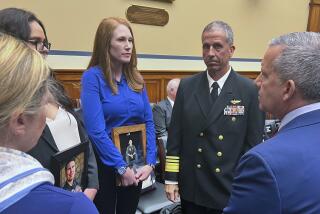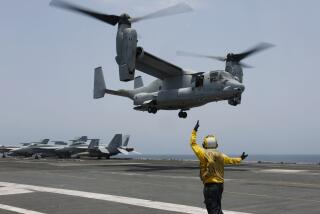COLUMN ONE : Warplane Survives Attacks : The defense secretary twice tried to kill the V-22 Osprey, part plane and part helicopter. Here’s how the aircraft was saved in the face of severe budget-cutting.
WASHINGTON — On a clear Washington day last spring, a flashy red-white-and-blue warplane glided smoothly toward the U.S. Capitol, hovered helicopter-style over the neatly tended lawn and landed--to hearty applause--beside a throng of well-wishers assembled on the steps.
It was a spectacle of the sort that only the military can produce--a heart-pounding mixture of impressive new weaponry and patriotic spirit, designed to win a place in the budget for yet another piece of military hardware.
But the audience--composed mainly of lawmakers and lobbyists--was entirely civilian. Nary a uniform was in sight.
The reception was typical of what has greeted the plane, a V-22 Osprey, since its inception. The Osprey--a tilt-rotor aircraft that can fly like a conventional plane and take off and land like a helicopter--has passed initial muster at the Defense Department, but Pentagon planners since have concluded that the $30-billion price tag simply is too expensive. In 1989, Defense Secretary Dick Cheney announced the Osprey would be the first major U.S. weapons system to be eliminated by the Bush Administration in the face of increasing pressures for defense cutbacks. And he has been trying to kill it ever since.
But the Osprey, named after a particularly stubborn fish hawk, has held on tenaciously, and has become the most intrepid survivor yet of the sweeping post-Cold War defense cutback which, in the past two years, has slashed $244 billion from the Pentagon’s five-year spending program, a plan that initially totaled $1.75 trillion over six years. For two years in a row, the House and Senate Armed Services committees have overturned the Pentagon’s kill recommendation for the Osprey, and the aircraft is conspicuously in the budget that Congress passed Oct. 27.
How can such a program survive those odds?
The story of how the Osprey has remained alive is a fascinating tale that involves a bitter cat fight between Pentagon budget-cutters and pork-barrel politicians, an unlikely crusade initiated by a junior congressman, the threat of unwanted competition from the Japanese, and an intriguing new defense-spending strategy for the 1990s that calls for selling a weapons system to Congress on the notion that it can be adapted for civilian use as well.
“This program has become a competitiveness issue, and this is a new wrinkle,” says Gordon Adams, director of the Washington-based Defense Budget Project, which is critical of military spending patterns. “That’s a sure sign of a declining defense budget--that you’re going to have to make a broader case for a new defense program,” Adams says. “And to the extent that defense contractors feel they have to do that, it’s probably a good thing.”
The Osprey’s saga began in 1986, during the Ronald Reagan Administration’s $3-trillion defense buildup, when the aircraft--then known by the designation JVX--had quietly won initial acceptance in the Pentagon’s tortuous weapons-acquisition process. In the weapons-buying frenzy of the day, the JVX--built jointly by Bell Helicopter of Ft. Worth and Boeing Helicopter of Philadelphia--drew little attention from critics.
Bright Future Seen
By the time Cheney came to office in March, 1989, the Osprey appeared destined for a bright future. The Pentagon had spent $1.3 billion to develop the plane. Four test models had been built or approved for construction, and the Marine Corps had promised to buy 552 Ospreys once production began.
But in early 1989, the Osprey began encountering some ominous crosswinds: Auditors in the Pentagon’s Office of Program Analysis and Evaluation, an internal watchdog agency whose staffers were known as the Whiz Kids, issued a report arguing that the military could perform the same jobs tens of billions of dollars more cheaply by using standard helicopters that already were on hand. The Osprey, in short, was proving too expensive--and unnecessary.
With anti-defense-spending sentiment burgeoning--and orders from the White House to slash billions from the Pentagon budget--it was an argument that Cheney, himself a former congressman, could not resist. On April 25, 1989, pleading that “painful cuts” had to be made, Cheney announced he was eliminating the Osprey program. “I had to cut somewhere, and rather than stretch out all the programs and run everything at an inefficient rate, I opted for knocking specific programs out of the budget,” he said.
While the Osprey was designed to carry 24 combat-ready troops and would be able to land where no fixed-wing aircraft would dare to tread, Cheney agreed with the argument that already available helicopters could do that too, and for a lot less cost.
Cheney’s decision caused some mild expressions of surprise on Capitol Hill, where lawmakers had cynically come to expect that the Pentagon would never recommend killing a program on its own. But to Rep. Curt Weldon (R-Pa.), this was nothing short of stunning. With 2,000 jobs in his largely suburban Philadelphia-area district dependent on the program--and the promise of many more if the Osprey program ever really took off, Weldon downplayed his earlier speeches on community firefighting programs and began what eventually would become an almost one-man crusade to keep the Osprey aloft.
As a junior member of the House Armed Services Committee, Weldon at least had some entree to Congress’ deliberations on the Osprey. But the outlook was hardly promising. As the House panel moved later in the summer of 1989 to draft the 1990 defense bill, its chairman, Rep. Les Aspin (D-Wis.), was against opposing Cheney on the V-22.
But Weldon secured backing for the Osprey by joining his forces with another group of lawmakers whose own pet project, the F-14 fighter, had also been on Cheney’s hit list. The alliance threw V-22 supporters together with lawmakers who had home-district ties to the Grumman Corp. of Bethpage, N.Y., the F-14’s manufacturer, and its subcontractors in New York, California and elsewhere.
The coalition included a sizable group of congressional aircraft-carrier enthusiasts, who feared that the Pentagon was buying too few planes for the Navy’s 15-carrier fleet. The Osprey program alone guaranteed support of the Pennsylvania and Texas delegations, in whose districts the plane would be manufactured.
To Weldon’s delight, the effort succeeded. The panel’s final bill earmarked $1 billion for additional F-14s and $351 million for the development and early production of the Osprey. The Senate--indifferently--went along.
But Cheney refused to give up. The following January, he threw down the gauntlet, serving notice that the Pentagon would not use the money earmarked for early production of the V-22, but would shift the funds instead to meet the Defense Department’s other priorities. In early February, when the Administration sent Congress its budget for fiscal 1991, the Osprey program was missing--again. Round 2 had begun.
Weldon knew he would have a tougher fight on his hands this time, and moved quickly to make sure his troops would be on board. In January, he called executives of the Osprey’s two major manufacturers, Bell Helicopter President L. M. (Jack) Horner and Boeing Helicopter President Edward Renouard, into his office and gave them an ultimatum: Weldon was prepared to “go to the wall” for the V-22, but the manufacturers had to be ready to pull out the stops as well.
The decision wasn’t an easy one for the two firms. If they continued to oppose Cheney’s kill order, it might well strain their relations with the Defense Department, which is their single biggest customer. And to make matters worse, Boeing--a principal contractor on the B-2 Stealth bomber as well--was already tied up in a much bigger lobbying fight for that program, which was under attack on Capitol Hill and also about to be scaled back by Cheney. But eventually, the two executives told Weldon they would go along.
Approaches Military
The young Pennsylvania lawmaker then delicately approached military brass for a similar commitment. The Marines said they’d go along--” verrry carefully,” Weldon, 43, recalls. “Believe me, I would never have fought this battle if the military leaders had told me, ‘Curt, you’re wasting your time, we don’t want this,’ ” the congressman insists.
With that backing in hand, the Osprey supporters came up with a novel--and soon-to-be-successful--strategy: They would seek to broaden congressional support for the V-22 by selling lawmakers on its potential as a short-hop commuter plane. The Osprey’s tilt-rotor technology not only would open routes to cities that currently had no major airport, but it also could save older airports millions of dollars in runway improvements necessary to accommodate bigger planes, the Osprey lobby would argue. Some analysts predicted the civilian market for the Osprey ultimately could approach more than 2,000 aircraft--almost four times the Pentagon’s projected buy.
To some, the Osprey aircraft sets a standard for future Pentagon programs in lean budgetary times. Like the V-22, they say, those weapons most worthy of support will be multitalented workhorses that will benefit the civilian sector as well.
“You can’t sell a B-2 bomber to Trans World Airlines, and you can’t sell a nuclear-powered submarine to Carnival Cruise Lines, but the V-22, everybody’s champing at the bit to get,” Weldon asserts.
Meanwhile, the campaign continued--and does even today. The red-white-and-blue Osprey that landed on the east front of the Capitol last spring also made appearances at the Dayton Airshow, in New York’s Battery Park and at other spectacles across the country. Bell Helicopter’s Horner crisscrossed the country speaking to the editorial boards of newspapers. On Feb. 21, Weldon and several other lawmakers took to the steps of the Smithsonian Institution’s Air and Space Museum--a warehouse of aerospace technologies pioneered by the Pentagon--to announce the creation of the “Tilt-Rotor Technology Coalition.” And the Osprey Lobby, as it is disparagingly known, has published dozens of ads hailing the airplane’s attributes.
Bell Helicopter and Boeing both have compiled lists of Osprey subcontractors in each congressional district and circulated them to Weldon’s Tilt-Rotor Technology Coalition, which has been hard at work spreading the message. And the manufacturers used their own nationwide reach--”the network of our subcontractors and their employees,” Bell Helicopter’s Horner says. “Our Textron family, and all 33 divisions of Textron (Bell’s parent firm) and their chairmen talked to their employees and chambers of commerce.”
Their contentions found receptive ears. In California alone, preliminary surveys by the state Transportation Department concluded that tilt-rotor planes could relieve airport congestion significantly for as many as 13 million passengers a year on shuttle service connecting Los Angeles, San Diego and San Francisco. If the lawmakers voted to support the Osprey program, the local communities could have the aircraft, and the Pentagon would be forced to pay the cost of developing it, both lawmakers and local officials reasoned. The peace dividend--of sorts--finally had arrived.
The tactic worked--instantly. Within weeks, the Osprey program counted among its supporters everyone from shuttle-magnate Donald Trump and hostage-rescuer H. Ross Perot Jr. to Rep. James L. Oberstar (D-Minn.), chairman of the aviation subcommittee of the powerful Public Works and Transportation Committee. More important, the civilian potential openly beckoned the support of virtually every lawmaker whose constituency traveled by air.
Threat of Competition
The blossoming campaign also got an unexpected boost from the threat of competition from Japan. Early last spring, visiting Japanese Trade Minister Hikaru Matsunaga told the Osprey’s U.S. manufacturers: “If you produce this aircraft, I guarantee you we will buy it. If you do not, I guarantee we will build it ourselves.”
For congressional backers of the plane, Matsunaga’s challenge amounted to fighting words--and added a whole new “international competitiveness” dimension to the Osprey. Suddenly, a plane that was sold initially as a military weapon--critical to future Marine landings, to Third World commando raids and to search-and-rescue missions--had become a test of America’s will to defend its historic lead in aerospace against a burgeoning Japanese threat.
Lobbyists for the Osprey seized on the new opening in grand style. In July, just days before the House and Senate Armed Services committees moved to draft their versions of the 1991 defense spending bill, the manufacturers of the Osprey underscored the new trade stake by placing a Korean-made toy model of the plane on the desk of every lawmaker.
In an accompanying letter, three House members in whose districts the Osprey would be built warned colleagues that “our fiercest economic competitors have already duplicated the model, and they are avidly pursuing development of their own tilt-rotor aircraft. . . . Our technological leadership can quickly erode.”
Perhaps unsurprisingly, Congress, more preoccupied than ever about jobs, unfair trade practices and the future of U.S. industry, this year demanded to continue the Osprey, and insisted that the Pentagon--traditionally the incubator for new aerospace technology--must pay to build it. If the Defense Department refused to pioneer and adopt the revolutionary tilt-rotor technology, Osprey proponents argued, the United States would cede to Japan its long-held dominance in the civilian aircraft of the future.
But supporters insist as well that while politics and pork barrel might have won the Osprey a stay of execution, only the plane’s multifaceted potential can explain Congress’ continued defiance of the Pentagon’s termination-order.
And in the end, fate--in the person of Iraqi President Saddam Hussein--may have intervened to make a final pitch for the Osprey. Iraq’s invasion of Kuwait--and the massive deployment of military forces to Saudi Arabia--appear to have hardened Congress’ growing resistance to financing bombers and nuclear missiles, and intensified its shift toward weapons designed for use in Third World conflicts.
Humiliated in his defeat when his recommendation to kill the Osprey was overturned in 1989, the House Armed Services Committee’s Aspin this year has backed the Osprey lobby’s bid to restore $603 million for the program--including $438 million for early production of the first full-scale aircraft. Operation Desert Shield “proves the wisdom” of such committee actions, Aspin said in a speech following the panel’s drafting session.
V-22 OSPREY: BUDGET-CUTTERS TARGET
The V-22 Osprey is a tilt-rotor aircraft that can fly like a conventional plane and take off and land like a helicopter. The potential-- uses of the Osprey would involve ship-to-shore assault, special operations raids, search-and-rescue and drug traffic surveillance. It could eventually be used in commercial aviation, drastically reducing the amount of land required for new airports. Program cost: $30 billion Primary contractors: Bell Helicopter Textron Inc., and Boeing Helicopter Crew/Accomodation: Three, plus up to 24 troops. Power Plant: Two 6,150 shp Allison T406-AD-400 turboshafts. Dimensions: Overall length 57 ft. 4 in.; Rotor diameter 38 ft. Weights: Empty weight 31,886 pounds; maximum take-off weight 47,500 pounds. Performance: Maximum speed at sea level 308 knots (357 m.p.h.); Cruising speed 100 knots (115 m.p.h.). Maximum range is 2,416 miles.
Source: Encyclopedia of World Aircraft and Jane’s All the World’s Aircraft
More to Read
Sign up for Essential California
The most important California stories and recommendations in your inbox every morning.
You may occasionally receive promotional content from the Los Angeles Times.











